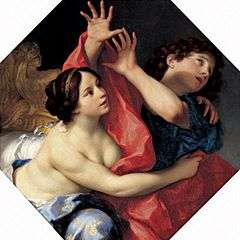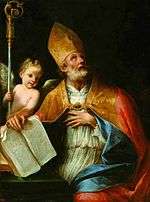Carlo Cignani
| Carlo Cignani | |
|---|---|
 Self-portrait | |
| Born |
15 May 1628 Bologna |
| Died |
8 September 1719 (aged 91) Forlì |
| Nationality | Italian |
| Known for | Painting |
| Movement | Baroque |

Carlo Cignani (15 May 1628 – 8 September 1719) was an Italian painter of the Bolognese and of the Forlivese school, active in the Baroque period.
He was born to a family of noble ancestry, but limited resources, in Bologna. His father's first name was Pompeo, and his mother, Maddalena Quaini.[1]

In Bologna, he studied first under Battista Cairo[2] and later under Francesco Albani, to whom he remained closely allied, and was his most famous disciple. His first noted commission was a St Paul exorcising demon for the church of the Gesu in Bologna. For a hall dedicated to the Farnese in the Palazzo Publico, he painted with Taruffi, depicting the Francis, king of France, curing Scrofula on his entry to Bologna and the Entry of Paul III Farnese to Bologna'.[3]
He was, however, also strongly influenced by the genius of Correggio, and by the masterworks by Melozzo da Forlì. For instance, his masterpiece, the Assumption of the Virgin, around the cupola of the church of the Madonna del Fuoco at Forlì, is inspired by the Correggio's frescoes in the cupola of the Cathedral of Parma and by the Melozzo's perspective from down to up. These frescoes occupied Cignani for some twenty years.
In 1681, Cignani returned to Bologna from Parma. He opened an accademia del nudo for painting from models and had as one of his pupils Giuseppe Maria Crespi.
He had some of the defects of his masters: his elaborate finish and his audacious artificiality in the use of color and in composition mark Albani's influence. Despite that, he imparted to his work more of an intellectual character than his mentors. As a man Cignani was eminently amiable, unassuming and generous.
He accepted no honors offered him by the duke of Parma, but lived and died an artist. In 1686 he moved to Forlì, where he died. When the Accademia Clementina for Bolognese artists was founded in 1706, Cignani was posthumously elected Principe in absencia for life. His most famous pictures, in addition to the Assumption already cited, are the Entry of Paul III into Bologna; the Francis I Touching for Kings Evil; a Power of Love, painted under a fine ceiling by Agostino Carracci, on the walls of a room in the ducal palace at Parma; an Adam and Eve (at The Hague); and two of Joseph and Potiphars Wife (at Dresden and Copenhagen).
His son Felice Cignani (1660–1724) and nephew Paolo Cignani (1709–1764) were also painters. His most noted pupils were Marcantonio Franceschini and Federico Bencovich. Other pupils include Giacomo Boni, Andrea and Francesco Bondi; Giovanni Girolamo Bonesi; Girolamo Domini; Pietro Donzelli; Francesco Galli; Bonaventura Lamberti; Matteo Zamboni; Camilla Lauteri; Stefano Maria Legnani; Charles Lucy (1692 - after 1767), Francesco Mancini; Paolo Antonio Paderna.,[4] and Sante Vandi.[5]
Anthology of works
| Wikimedia Commons has media related to Carlo Cignani. |
- Magdalen, Dulwich Picture Gallery
- Joseph and Potiphar's Wife (c. 1680), Oil on canvas, 99 x 99 cm, Gemäldegalerie, Dresden
- Joseph and Potiphar's Wife, Musee Fesch, Ajaccio
- Charity Oil on canvas, 119.4 x 161.3 cm, San Francisco Museum of Art
- Judgement of Paris (1691), Oil on canvas, 130.5 x 161 cm,
- Aurora, Circolo della Scranna, Forlì
- Incoronazione di Santa Rosa (Coronation of Saint Rose of Lima), Oil on canvas, Forlì, Pinacoteca Civica
- Self-portrait, Oil on canvas, Forlì, Pinacoteca Civica
- With Felice Cignani, La Vergine e San Filippo Neri (The Virgin and Saint Philip Neri), Oil on canvas, Forlì, Pinacoteca Civica.
Gallery
 Madonna and Child
Madonna and Child Metamorphosis of Daphne
Metamorphosis of Daphne Rape of Europa
Rape of Europa Pastor and Pastora
Pastor and Pastora Moses saved from the River
Moses saved from the River_Bellona_bem%C3%A4chtigts_sich_der_Waffen_Amors.jpg) Bellona in Love
Bellona in Love Bacchus and Ariadne
Bacchus and Ariadne
References
- ↑ Zanelli, page 3-4.
- ↑ Possibly, Giovanni Battista Cairo, father of Francesco Cairo.
- ↑ Zanelli, page 9.
- ↑
- Hobbes, James R. (1849). Picture collector's manual adapted to the professional man, and the amateur. T&W Boone, 29 Bond Street; Digitized by Googlebooks. pp. 51–52.
- ↑ Dizionario degli architetti, scultori, pittori, intagliatori d'ogni By Stefano Ticozzi, page 449, 1832
 This article incorporates text from a publication now in the public domain: Chisholm, Hugh, ed. (1911). "Cignani, Carlo". Encyclopædia Britannica. 6 (11th ed.). Cambridge University Press. pp. 364–365.
This article incorporates text from a publication now in the public domain: Chisholm, Hugh, ed. (1911). "Cignani, Carlo". Encyclopædia Britannica. 6 (11th ed.). Cambridge University Press. pp. 364–365.- Spike, John T. (1986). Centro Di, ed. Giuseppe Maria Crespi and the Emergence of Genre Painting in Italy. Fort Worth: Kimball Museum of Art. pp. 14–15.
- Ippolito, Zanelli (1722). Vita del Gran Pittore Cavalier Carlo Cignani. Bologna: Nella Stamperia di L. dalla Volpe.
- Cignani Family - article from the Catholic Encyclopedia